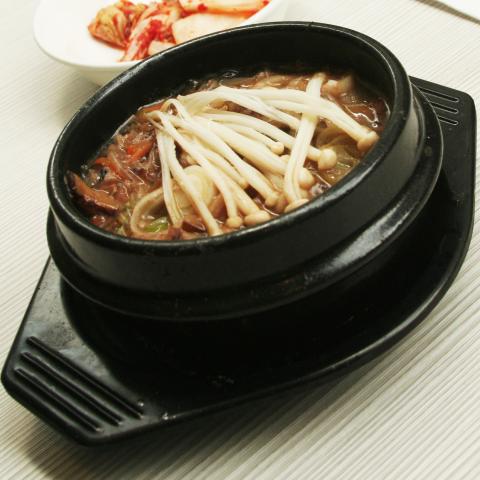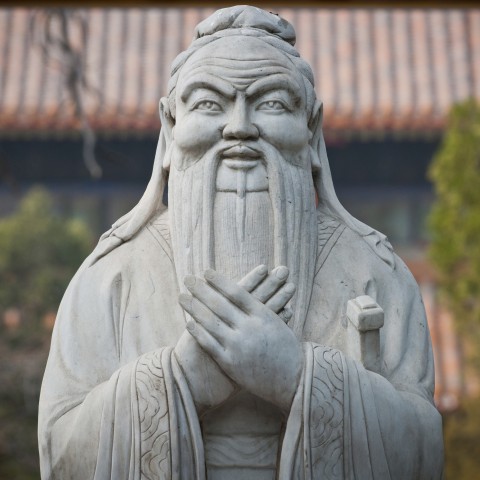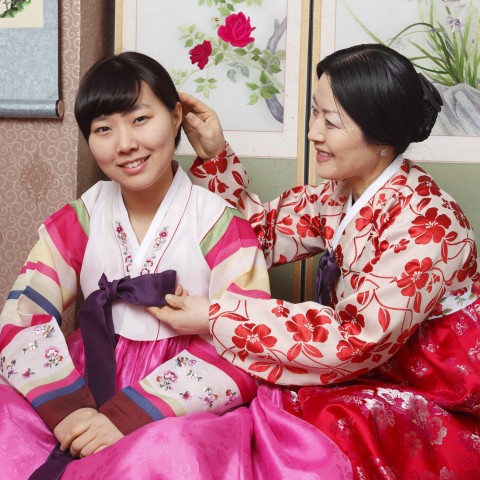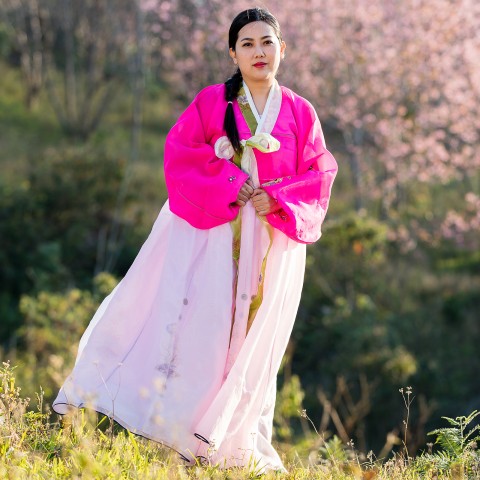
There’s no denying that K-Pop has taken over the world and played a huge role in popularizing the Korean language. According to The Korea Herald, the King Sejong Institute is busy at work opening new Korean-language learning centers around the globe. This institute currently operates 172 branches and teaches Korean to 57,000 students in 56 different countries.
Whether you’re learning the Korean language to understand the lyrics of your favorite K-Pop songs or to follow along with the subtitles for Korean films, you’ve come to the right place!
Korean tenses are an essential part of the Korean language you should become familiar with early on. In today’s article, we’ll teach you about the present, past, and future tenses in Korean and show you how they’re formed. The information provided here is intended for beginners, but intermediate and advanced students can also read it to brush up on their skills.
Let’s go!

Having a goal is very important in learning the Korean language.
 Table of Contents
Table of Contents
1. Present Tense
The Korean present tense is used to describe something that is happening in the present. Take the English phrases “I eat” and “I drink,” for example. There are three different ways to form the present tense in Korean.
RULE #1
When the last syllable of the stem ends in a consonant, -는다 (-neunda) is added to the stem of the word.
For example:
- 먹다 (meokda) – “to eat”
- 먹 (meok) + 는다 (neunda) = 먹는다 (meokneunda) or “I eat”
- 닫다 (datda) – “to close”
- 닫 (dat) + 는다 (neunda) = 닫는다 (datneunda) or “I close”
Example sentences:
- 라면을 먹는다. (Ramyeoneul meokneunda.) – “I eat ramen.”
- 문을 닫는다. (Muneul datneunda.) – “I close the door.”
RULE #2
When the last syllable of the stem ends in a vowel, -ㄴ (-n) is added to the last syllable followed by 다 (da).
For example:
- 배우다 (baewuda) – “to learn”
- 배우 (baewu) + ㄴ다 (nda) = 배운다 (baewunda) or “I learn”
- 공부하다 (gongbuhada) – “to study”
- 공부하 (gongbuha) + ㄴ다 (nda) = 공부한다 (gongbuhanda) or “I study”
- 가다 (gada) – “to go”
- 가 (ga) + ㄴ다 (nda) = 간다 (ganda) or “I go”
- 오다 (oda) – “to come”
- 오 (o) + ㄴ다 (nda) = 온다 (onda) or “I come”
Example sentences:
- 영어를 배운다. (Yeongeoreul baewunda.) – “I learn English.”
- 한국어를 공부한다. (Hangukeoreul gongbuhanda.) – “I study Korean.”
- 집으로 간다. (Jibeuro ganda.) – “I go home.”
- 친구가 온다. (Chinguga onda.) – “My friend comes.”
RULE #3
This grammar rule is used to describe something happening right now, such as “I am eating” and “I am drinking” in English.
Remove the stem and simply add -고 있어요 (-go itseoyo) to complete the sentence.
For example:
- 먹다 (meokda) – “to eat”
- 먹 (meok) + 고 있어요 (go isseoyo) = 먹고 있어요 (meokgo isseoyo) or “I’m eating”
- 마시다 (masida) – “to drink”
- 마시 (masi) + 고 있어요 (go isseoyo) = 마시고 있어요 (masigo isseoyo) or “I’m drinking”
- 입다 (ibda) – “to put on” or “to wear”
- 입 (ib) + 고 있어요 (go isseoyo) = 입고 있어요 (ipgo isseoyo) or “I’m wearing”
Example sentences:
- 밥을 먹고 있어요. (Babeul meokgo isseoyo.) – “I am eating some rice.”
- 물을 마시고 있어요. (Mureul masigo isseoyo.) – “I am drinking some water.”
- 드레스를 입고 있어요. (Deureseureul ipgo isseoyo.) – “I am wearing a dress.”

The conversation will be a lot smoother if you can construct tenses correctly.
2. Past Tense
The past tense is used to describe actions that took place at some point in the past, which is especially important in storytelling or conveying certain types of information. There are three ways to form the Korean past tense.
RULE #1
When the final vowel of a verb is ㅗ (o) orㅏ(a), add -았다 (-atda).
For example:
- 만나다 (mannada) – “to meet”
- 만나 (manna) + 았다 (atda) = 만났다 (manatda) or “I met”
- 가다 (gada) – “to go”
- 가 (ga) + 았다 (atda) = 갔다 (gatda) or “I went”
Example sentences:
- 친구를 만났다. (Chingureul mannatda.) – “I met a friend.”
- 집으로 갔다. (Jibeuro gatda.) – “I went home.”
RULE #2
When the final vowel of a verb is anything but ㅗ (o) orㅏ(a), add -었다 (-eotda).
For example:
- 먹다 (meokda) – “to eat”
- 먹 (meok) + ~았다 (-atda) = 먹었다 (meokatda) or “I ate”
- 배우다 (baewuda) – “to learn”
- 배우 (baewu) + ~았다 (-atda) = 배웠다 (baeweotda) or “I learned”
Example sentences:
- 수박을 먹었다. (Subageul meogeotda.) – “I ate a watermelon.”
- 한국어를 배웠다. (Hangugeoreul baeweotda.) – “I studied Korean.”
RULE #3
If a verb ends with the syllable 하 (ha), add -였다 (-yeotda).
For example:
- 요리하다 (yorihada) – “to cook”
- 요리하 (yoriha) + 였다 (yeotda) = 요리했다 (yorigatda) or “I cooked”
- 공부하다 (gongbuhada) – “to study”
- 공부하 (gongbuha) + 였다 (yeotda) = 공부했다 (gongbuhaetda) or “I studied”
Example sentences:
- 한식을 요리하다. (Hansigeul yorihada.) – “I cooked Korean dishes.”
- 요리를 공부했다. (Yorireul gongbuhaetda.) – “I studied cooking.”

Learning the Korean language takes time, but it’s absolutely worth it!
3. Future Tense
The future tense is used to talk about future events. There are two Korean future tenses: one that describes something that will happen in the future and one that describes what might happen.
Simple Future Tense
The simple future tense is very easy to learn because all you need to do is add -겠다 (-getta) to the stem of a verb. Simple, right?
For example:
- 배우다 (baewuda) – “to learn”
- 배우 (baewu) + 겠다 (getda) = 배우겠다 (baewugetda) or “I will learn”
- 먹다 (meokda) – “to eat”
- 먹 (meok) + 겠다 (getda) = 먹겠다 (meokgetda) or “I will eat”
- 가다 (gada) – “to go”
- 가 (ga) + 겠다 (getda) = 가겠다 (gagetda) or “I will go”
- 키우다 (kiuda) – “to raise”
- 키우 (kiu) + 겠다 (getda) = 키우겠다 (kiugetda) or “I will raise”
Example sentences:
- 포토샵을 배우겠다. (Potosyapeul baewugetda.) – “I will learn Photoshop.”
- 나중에 먹겠다. (Najunge meokgetda.) – “I will eat later.”
- 저녁에 가겠다. (Jeonyuge gagetda.) – “I will go in the evening.”
- 토끼를 키우겠다. (Tokkireul kiwugetda.) – “I will raise a rabbit.”
Probable Future
The probable future tense is used when you want to say, “I will probably ___.” The rule is to attach 으 (eu) or ㄹ 거에요 (r geoyeyo) to the verb stem.
Here are the rules:
1) If the stem ends in a consonant, attach 을 거예요 (eul geoyeyo).
2) If it ends in a vowel, attach ㄹ 거예요 (r geoyeyo).
- 먹다 (meokda) – “to eat”
- 먹 (meok) + 을 거예요 (eul geoyeyo) = 먹을 거예요 (meogeul geoyeyo) or “I will probably eat”
- 가다 (gada) – “to go”
- 가 (ga) + ㄹ 거예요 (r geoyeyo) = 갈 거예요 (gal geoyeyo) or “I will probably go”

Revise, revise, and revise! It is the fastest way to learn Korean well.
4. Revise Your Knowledge with KoreanClass101!
How about a quick exercise to revise everything you’ve learned today?
Below is a table featuring words from our free list “Vocabulary for the 25 Most Commonly Used Verbs of Any Language.” You can either print out this page or get a notebook ready, and fill in the answers for the blank cells. Don’t be discouraged if you struggle to remember the correct answers! When you’re done with the exercise, simply drag each column to see the answer.
| Dictionary Form | Present Tense | Past Tense | Future Tense |
| 먹다 (meokda) | 먹는다 (meokneunda) | 먹었다 (meokeotda) | 먹겠다 (meokgetda) |
| 가다 (gada) | 간다 (ganda) | 갔다 (gatda) | 가겠다 (gagetda) |
| 사용하다 (sayonghada) | 사용한다 (sayonghanda) | 사용했다 (sayonghaetda) | 사용하겠다 (sayonghageta) |
| 보다 (boda) | 본다 (bonda) | 봤다 (bwatda) | 보겠다 (bogetda) |
| 일하다 (ilhada) | 일한다 (ilhanda) | 일했다 (ilhaeta) | 일하겠다 (ilhageta) |
| 말하다 (malhada) | 말한다 (malhanda) | 말했다 (malhaetda) | 말하겠다 (malhagetda) |
| 오다 (oda) | 온다 (onda) | 왔다 (watda) | 오겠다 (ogetda) |
| 마시다 (masida) | 마신다 (masinda) | 마셨다 (masyeotda) | 마시겠다 (masigetda) |
| 자다 (jada) | 잔다 (janda) | 잤다 (jatda) | 자겠다 (jageta) |
| 생각하다 (saengakhada) | 생각한다 (saengakhanda) | 생각했다 (saengakhaetda) | 생각하겠다(saengakhageta) |
| 알아듣다 (aladeutda) | 알아듣는다 (aladeutneunda) | 알아들었다 (aladeuleotda) | 알아들겠다 (aladeulgetda) |
| 물어보다 (mureoboda) | 물어본다 (mureobonda) | 물어봤다 (mureobwatda) | 물어보겠다 (mureobogetda) |
| 주다 (juda) | 준다(junda) | 줬다 (jweotda) | 주겠다 (jugetda) |
| 시작하다 (sijakhada) | 시작한다(sijakhanda) | 시작했다 (sijakhaetda) | 시작하겠다 (sijakhagetda) |
How many did you get right? If you’re still struggling to understand Korean tenses, go back to the corresponding section from the article and try it again. Practice makes perfect!
Here’s another list of Korean verbs from our website that you can use to practice the past, present, and future tenses:
And here are lessons that we made just for you (that is, if you’re an absolute beginner):
- Korean Past Tense: Did You Wash Yourself or Brush Your Teeth?
- Using Korean Future Tense: When Are You Going on Vacation?
- I Did It, I’m Doing It, And I’m Going To Do It
Did you find those too easy? Here are some pages for intermediate and advanced learners:
Check out these other pages from the web to learn more about Korean-language verbs in general:
- Korean verbs (Wikipedia)
- Korean verbs (Wiktionary)
5. Why Learn with Us?
KoreanClass101 offers free vocabulary lists and a free dictionary where you can learn new words and practice their pronunciation. We also have a Korean word of the day feature, which allows you to receive a free daily Korean lesson from us. We know that some Korean learners love challenging themselves by memorizing a word everyday, so we’ve also compiled the Korean Core 100 Word List so that you can challenge yourself and learn Korean words that are used every day in Korea. We also have 200-, 300-, and 2000-word lists! So do check them out if you’re up to the challenge!
Have a question? Feel free to leave a comment below or simply visit our forum page where you can learn all about Korea and practice your language skills. A lot of Korean learners share their Korean travel experiences and provide learning tips here. In addition, native Korean speakers also visit this page to help Korean learners like yourself.
We hope you enjoyed reading this article, and good luck with your Korean studies!

How Long Does it Take to Learn Korean?

Many aspiring Korean learners are plagued by a common question: How long does it take to learn Korean?
Unfortunately, there’s no definite answer. It really depends on a number of factors, such as your native language, education, experience with languages, exposure, and motivation.
Your intended proficiency level also plays a role in determining how long it takes to learn the Korean language. Do you want to be able to…
- …read simple Korean words?
- …hold a conversation with locals?
- …work in South Korea?
Each of these goals requires a different skillset and time commitment, so keep this in mind before taking the leap and beginning your studies.
In this article, you’ll learn how to estimate how long it will take you to learn the Korean language based on your background and the proficiency level you have in mind. As a reference point, we’ll be using standards from the TOPIK proficiency test.

Mastering the Korean language takes time and effort.
 Table of Contents
Table of Contents
- The Many Factors That May Impact Your Studies
- TOPIK Beginner’s Level
- TOPIK’s Intermediate Level
- TOPIK’s Advanced Level
- How KoreanClass101 Can Help You Reach Your Goals
The Many Factors That May Impact Your Studies
Before we jump right into how long it takes to reach each level, there are a few factors you need to keep in mind.
Your Native Language vs. Korean
Thanks to King Sejong, you don’t need to learn all the complicated Chinese characters to learn Korean! But you do need to understand that Koreans use Sino-Korean vocabulary, which refers to Korean words of Chinese origin and words directly borrowed from the Chinese language. For this reason, if your first language is Chinese or Japanese (Kanji), you’ll get the hang of Sino-Korean vocabulary a lot faster than speakers of other languages will.
Your Language Learning Experience
If you already speak a foreign language or have been raised in a bilingual (or even a trilingual) environment, you’ll save so much time! It’s usually faster to pick up a third or fourth language than it is to learn a second language. A new study from the University of Haifa revealed that bilinguals can pick up a third language more effectively than monolinguals can a second language. This is because bilinguals have already developed an aptitude for language learning.
Your Motivation and Attitude
Whether you want to learn the Korean language to understand the lyrics of your favorite K-pop songs or because you want to work in South Korea, your motivation and attitude toward learning Korean will significantly affect how quickly you pick up the language.
Learning Methods
Are you planning to study Korean casually on your own? Or are you already in a Korean-speaking country and fully immersed in the language? Maybe you want to go to a language school or learn online? There are many different learning methods out there, so make sure you choose the one that suits you best.

Little by little, you’ll reach the level you want.
TOPIK Beginner’s Level
Reaching the beginner level of Korean is a huge milestone and a victory that will propel you forward in your studies. But how long does this usually take?
The TOPIK test ranks beginners as either Level 1 or Level 2, depending on how well they score. Here’s what each level means:
Level 1
Level 2
|
At this level, you’ll have a very limited vocabulary but can participate in greetings or short talks about your day. It will take about three to six months to reach the beginner level, depending on your study schedule. At this point, it’s important to master Korean spelling and to build a strong fundamental grammar foundation. Without this foundation in place, it will be challenging for you to move forward.
The perfect way to study at this stage is to write each Korean character down on a piece of paper several times until you have each one memorized. To start, you can download free PDF materials from KoreanClass101.com on the page Learn the Korean Alphabet, Hangul, from A to Z!
Once you’ve familiarized yourself with the Korean characters, move on to learning the basic Korean grammar rules. After that, I recommend you learn basic phrases for introducing yourself, greeting people, and even ordering food at a restaurant! KoreanClass101.com has you covered with the following lesson series:
- All About (15 Lessons • 1hr 54min)
- Absolute Beginner Season 1 (25 Lessons • 5hrs 1min)
- Listening Comprehension for Absolute Beginners (25 Lessons • 40min)
- Absolute Beginner Korean for Every Day (64 Lessons • 6hrs 20min)
Learning basic Korean grammar principles will help you build your vocabulary skills, too. Check out the pages below if you want to speed up your studies and learn the most important and commonly used words.
- Korean Core 100 Word List
- Korean Word of the Day
- Free Vocabulary Lists
- Korean words and phrases (Wikipedia)
At this level, flashcards will be your best friends! We recommend you check out a few different apps that provide a flashcard function.
If you’re struggling to understand the rules of grammar or anything related to the Korean language, ask around. Our Korean forum is a great place to ask questions to other Korean students as well as native Korean speakers.

The more you practice the Korean language, the faster you will reach the level you want!
TOPIK’s Intermediate Level
Your next milestone will be to reach the intermediate level of Korean. But what exactly does this look like, and how long will it take to get there? The TOPIK test has two intermediate level rankings: Level 3 and Level 4.
Level 3
Level 4
|
It can take anywhere from one to two years to reach Level 3, which equates to about 600 hours of studying.
At this level, you have familiarized yourself with Korean spelling and basic Korean grammar concepts. You also have the ability to hold short conversations and exchanges, such as greeting someone or buying items. Here are some KoreanClass101 lesson series you can study in conjunction with your textbooks:
- Daily Conversation: Lower Intermediate Korean (50 Lessons • 14hrs 37min)
- An Intermediate Korean Lesson Review (73 Lessons • 10hrs 22min)
- Intermediate Season 1 (25 Lessons • 7hrs 42min)
- Intermediate Season 2 (25 Lessons • 5hrs 11min)
In order to achieve Level 4, you should be willing to dedicate 2 to 4 years (or about 1,000 hours) of studying. The great news is that once you reach this level, you can start learning more complex grammar rules and a variety of verb conjugations used in advanced contexts.
If you’re studying on your own, this would be a good time to get at least a few hours of private lessons or online coaching to solidify your knowledge and make sure you’re on the right track. Also, watching Korean dramas, films, or even news stations is a great way to level up your Korean language skills. Here are a few more Korean resources you can check out on KoreanClass101.com:
- Listening Comprehension for Intermediate Learners (20 Lessons • 57min)
- Reading Comprehension for Intermediate Learners (10 Lessons • 15min)
- Upper Intermediate Season 1 (25 Lessons • 6hrs 46min)
This is only a snapshot of what we have to offer our learners. When you have time, explore our site to get an even better idea of how we can help you reach the intermediate level and beyond!

TOPIK’s Advanced Level
Are you shooting for the stars and hoping to attain an advanced level of Korean? Good for you—we know you can do it. But how long does it take to learn Korean fluently?
Level 5
Level 6
|
At this stage, you can use Korean fluently and accurately in academic or professional contexts.
If you want to achieve this level, be prepared. It will take at least a few years, though just how quickly you learn depends on you and your methods for studying. Nevertheless, expect to spend about 1,500 hours or more to get to this level.
Start watching Korean movies without subtitles, reading books, listening to Korean music, and most importantly, find native speakers you can interact with regularly. At this point, living in South Korea is the best option because you’ll get a massive dose of real-life Korean every day. You’ll constantly be introduced to new accents, slang terms, and idiomatic expressions you wouldn’t find in grammar books.
Here are some additional study materials for you as you progress from intermediate to advanced:
- Conversation Starters for Advanced Listeners (12 Lessons • 1hr 4min)
- Listening Comprehension for Advanced Learners (20 Lessons • 1hr 10min)
- Advanced Audio Blog 1 (30 Lessons • 1hr 33min)
- Advanced Season 1 (12 Lessons • 3hrs 22min)

How KoreanClass101 Can Help You Reach Your Goals
In this article, you learned how long it takes to learn Korean for each proficiency level, reviewed the many factors involved in calculating those numbers, and received some advice on how to learn Korean effectively at each stage. Feel free to let us know in the comments if you have any questions on what we covered today!
For many students, the ability to study Korean anywhere and anytime is a major factor in how motivated they are and how quickly they learn. Online classes are the best option in this regard, because they’re usually suitable for any level and are more affordable than attending school or paying for private lessons. There are plenty of free language learning websites that allow you to study from home at your own pace—so why choose KoreanClass101.com?
We make learning both fun and effective through proven teaching methods, and we cater our lessons to learners at each level. Even without a paid subscription, you can access tons of free Korean study materials:
- Vocabulary lists
- Video and audio lessons
- Podcasts
- Our YouTube channel
We also provide the option to upgrade to a Premium or Premium PLUS account for even more learning materials, exclusive content, and additional benefits. For example, Premium PLUS members can get one-on-one coaching with their own private tutor through MyTeacher.
Happy Korean learning! You can do this. 😉

The 11 Most Well-Known Korean Proverbs

Learning Korean proverbs is not only a great way to study the language, but also a window to the unique Korean culture. To help you get the most out of your language studies, we’ve put together this useful Korean proverbs list for you to study. Who knows—you may find that you can start applying these words of wisdom to your own life!
 Table of Contents
Table of Contents
- 꿩 먹고 알 먹는다 (kkwong meokgo al meongneunda)
- 보기 좋은 떡이 먹기도 좋다 (bogi joeun tteogi meokgido jota)
- 로마는 하루아침에 이루어진 것이 아니다 (romaneun haruachime irueojin geosi anida)
- 낮말은 새가 듣고 밤말은 쥐가 듣는다 (nanmareun saega deutgo bammareun jwiga deunneunda)
- 세 살 버릇 여든까지 간다 (se sal beoleus yeodeunkkaji ganda)
- 말 한마디에 천냥 빚도 갚는다 (mal hanmadie cheonnyang bijdo gapneunda)
- 궁하면 통한다 (gunghamyeon tonghanda)
- 뜻이 있는 곳에 길이 있다 (tteusi inneun gose giri itda)
- 병 주고 약 준다 (byeong jugo yak junda)
- 원숭이도 나무에서 떨어질 때가 있다 (wonsungido namueseo tteoreojil ttaega itda)
- 옷이 날개다 (osi nalgaeda)
- Want to Learn More? KoreanClass101 Can Help!
1. 꿩 먹고 알 먹는다 (kkwong meokgo al meongneunda)
Vocabulary List:
Literal Translation: Eat a pheasant and eat its egg.
Close English Proverb: Kill two birds with one stone.
This phrase is used to describe a situation where you do one action and receive two benefits at the same time.
For example, imagine that you finally decide to stop smoking to improve your health. You could use this phrase to emphasize that you would not only become healthier than before, but also spend less money on hospital visits and insurance.
Another example would be if you were cleaning your house and found a stack of money that you had completely forgotten about. In that case, you might say:
꿩 먹고 알도 먹고! 방 청소하다가 돈 찾았어.
Kkwong meokgo aldo meokgo! Bang cheongsohadaga don chajasseo.
“Kill two birds with one stone! I found some money while cleaning the house.”

2. 보기 좋은 떡이 먹기도 좋다 (bogi joeun tteogi meokgido jota)
Vocabulary List:
- 보기 (bogi) – “to see”
- 좋은 (joeun) – “and to be good”
- 떡 (tteok) – “rice cake”
- 먹기도 (meokgido) – “and to eat”
- 좋다 (jota) – “good”
Literal Translation: Good looking tteok (rice cake) tastes good too.
Close English Proverb: What looks good also tastes good.
When you see something that looks good, it will likely be of good quality. This is because the nice appearance shows that someone put a lot of effort into it.
Example:
민수: 이 책, 내용이 주제별로 잘 분류되어 있고 사진의 질도 참 좋네.
Minsu: I chaek, naeyongi jujebyeollo jal bunryudoeeo itgo sajinui jildo cham jonne.
Minsu: “The contents of this book are well-organized by topic, and the quality of the photos is great.”
철수: 보기 좋은 떡이 먹기도 좋다는데, 한번 읽어봐.
Cheolsu: Bogi joeun tteogi meokgido jotaneunde, hanbeon ilgeobwa.
Cheolsu: “What looks good is usually good too, so read it.”
3. 로마는 하루아침에 이루어진 것이 아니다 (romaneun haruachime irueojin geosi anida)
Vocabulary List:
- 로마 (roma) – “Roma”
- 하루아침 (haruachim) – “one morning”
- 이루어지다 (irueojida) – “be achieved”
Literal Translation: Rome wasn’t made in one morning.
Close English Proverb: Rome wasn’t built in a day.
This Korean proverb is used to remind us that we cannot expect to do important tasks really quickly, because quality work takes time. For example, it takes time and effort to become 몸짱 (momzzang), meaning someone with muscle.
Example:
민수: 나 헬스클럽 등록했어. 몸짱 빨리 되고 싶다.
Minsu: Na helseukeulleop deungnokaesseo. Momjjang ppalli doego sipda.
Minsu: “I registered for a health club. I want to gain muscle quickly.”
철수: 로마는 하루아침에 이루어진 것이 아닌건 알지?
Cheolsu: Romaneun haruachime irueojin geosi aningeon alji?maneun haluachim-e ilueojin geos-i aningeon alji?
Cheolsu: “You know that Rome didn’t happen overnight, right?”

4. 낮말은 새가 듣고 밤말은 쥐가 듣는다 (nanmareun saega deutgo bammareun jwiga deunneunda)
Vocabulary List:
- 낮말 (nanmal) – “words spoken during daytime”
- 새 (sae) – “bird”
- 밤말 (bammal) – “words spoken during nighttime”
- 쥐 (jwi) – “mouse”
- 듣는다 (deutneunda) – “listens”
Literal Translation: “Birds hear the words spoken in the day, and mice hear the words spoken at night.”
Close English Proverb: The walls have ears.
This proverb means that no matter how secretly you say something, others are likely to hear. If you know someone who spreads rumors or says bad things about others, you should step in and quote this Korean proverb.
Example:
민수: 너 내가 없을때 나에 대해 나쁜 얘기 했다면서?
Minsu: Neo naega eopseulttae nae daehae nappeun yaegi haetdamyeonseo?
Minsu: “You said bad things about me when I wasn’t there?”
철수: 아니 그런적 없는데?
Cheolsu: Ani geureonjeok eomneunde?
Chulsoo: “No, I didn’t.”
민수: 낮말은 새가 듣고 밤말은 쥐가 듣는다고, 너 말 조심하고 다녀.
Minsu: Nanmareun saega deutgo bammareun jwiga deunneundago, neo mal josimhago danyeo.
Minsu: “Birds listen during the day, and rats listen during the night. Watch your mouth.”
5. 세 살 버릇 여든까지 간다 (se sal beoleus yeodeunkkaji ganda)
Vocabulary List:
- 세 살 (se sal) – “3 years old”
- 버릇 (beoreut) – “habit” (usually bad habits)
- 여든 (yeodeun) – “80 years old”
- 까지 (kkaji) – “until”
- 간다 (ganda) – “to go”
Literal Translation: Habits (learned) at three last until one is eighty.
Close English Proverb: What’s learned in the cradle is carried to the grave.
This wise Korean proverb is used to warn that bad habits should be corrected early in life, since they’re very difficult to correct later in life. You could say this, for instance, when somebody keeps repeating the same mistakes.
Example:
민수: 세 살 버릇 여든까지 간다는 말 몰라? 그 버릇 때문에 힘들어질걸?
Minsu: Se sal beoreut yeodeunkkaji gandaneun mal molla? Geu beoreut ttaemune himdeureojilgeol?
Minsu: “Don’t you know the saying that 3-year-old habits last until you’re 80? You’re going to suffer from that habit!”
6. 말 한마디에 천냥 빚도 갚는다 (mal hanmadie cheonnyang bijdo gapneunda)
Vocabulary List:
- 말 (mal) – “saying”
- 한마디 (hanmadi) – “a single word”
- 천 (cheon) – “a thousand”
- 냥: (nyang) – “an old unit of Korean coinage”
- 빚 (bit) – “a debt”
- 도 (do) – “also”
- 갚는다 (gamneunda) – “to pay back”
Literal Translation: One word can repay a thousand nyang (old Korean currency) debt.
Close English Proverb: A good tongue is a good weapon.
This proverb highlights the importance of how you speak to people. You could use this proverb in a situation where someone is trying to persuade another party to do something; it would emphasize the importance of choosing their words carefully.
Example:
말 한마디에 천냥 빚도 갚는다고, 항상 말 조심해야해.
mal hanmadie cheonnyang bijdo gapneundago, hangsang mal josimhaeyahae.
“A good tongue is a good weapon, so be careful what you say.”

7. 궁하면 통한다 (gunghamyeon tonghanda)
Vocabulary List:
- 궁하면 (gunghamyeon) – “if you need something”
- 통한다 (tonghanda) – “it will open up”
Literal Translation: If you need something, it will open up.
Close English Proverb: There is always a way out.
This is a proverb often used to motivate others to find an innovative solution to a problem that otherwise seems helpless. For example, if a friend of yours wanted to become a YouTuber, you could use this proverb to encourage them.
Example:
민수: 유튜버가 되고 싶다.
Minsu: Yutyubeoga doego sipda.
Minsu: “I want to be a YouTuber.”
철수: 궁하면 통한다고 한번 해봐!
Cheolsu: Gunghamyeon tonghandago hanbeon haebwa!
Chulsoo: “Try it, maybe it will work!”
8. 뜻이 있는 곳에 길이 있다 (tteusi inneun gose giri itda)
Vocabulary List:
Literal Translation: In the place there is a will, there is a way.
Close English Proverb: Where there’s a will, there’s a way.
You can use this Korean proverb exactly the same way you would use its English equivalent. It means that a person can achieve anything, despite the difficulties, if they want it bad enough.
Example:
민수: 저 직장 너무 갖고 싶다.
Minsu: Jeo jigjang neomu gatgo sipda.
Minsu: “I really want that job.”
철수: 뜻이 있는 곳에 길이 있다고 열심히 해봐!
Cheolsu: Tteusi itneun gose giri itdago yeolsimhi haebwa!
Chulsoo: “Try hard because where there’s a will, there’s a way!”
9. 병 주고 약 준다 (byeong jugo yak junda)
Vocabulary List:
Literal Translation: Give a disease then give medicine.
Close English Proverb: To make trouble and then give help.
This proverb describes the actions of a deceptive person, who first causes harm and then offers a remedy in order to appear like the rescuer.
Example:
철수: 콜록콜록
Cheolsu: kollogkollog
Chulsoo: coughing
수미: 야! 너 감기 걸렸어?
Sumi: Ya! neo gamgi geollyeoss-eo?
Sumi: “Hey! Do you have a cold?”
다음날 (daeumnal) – “Next day”
수미: 콜록콜록
Sumi: kollogkollog
Sumi: coughing
철수: 미안해, 이 약 먹고 빨리 나아.
Cheolsu: Mianhae, i yag meoggo ppalli naa.
Chulsoo: “Sorry, I hope you get better with this medicine.”
수미: 지금 병 주고 약 주냐?
Sumi: Jigeum byeong jugo yag junya?
Sumi: “Are you being nice or nasty?”

10. 원숭이도 나무에서 떨어질 때가 있다 (wonsungido namueseo tteoreojil ttaega itda)
Vocabulary List:
- 원숭이 (wonesungi) – “a monkey”
- 도 (do) – “also” / “too”
- 나무 (namu) – “a tree”
- 에서(eseo) – “from”
- 떨어질 때가 (tteoreojil ttaega) – There is a time when one falls~
- 있다 (itda) – “there is”
Literal Translation: Monkeys sometimes fall from trees.
Close English Proverb: Even Homer sometimes nods.
Use this phrase to emphasize that even an expert sometimes makes mistakes.
Example:
민수: 저 피겨스케이터 전세계 1위인데도 넘어질때가 있네.
Minsu: Jeo pigyeoseukeiteo jeonsegye irwiindedo neomeojilttaega itne.
Minsu: “Even though she is the number-one figure skater in the world, she sometimes falls too.”
철수: 원숭이도 나무에서 떨어질 때가 있잖아.
Cheolsu: Wonsungido namueseo tteoreojil ttaega itjana.
Chulsoo: “Even Homer sometimes nods.”
11. 옷이 날개다 (osi nalgaeda)
Vocabulary List:
- 옷 (ot) – “clothing”
- 날개 (nalgae) – “wing”
Literal Translation: Clothes are your wings.
Close English Proverb: Dress to impress.
This proverb emphasizes the importance of dressing well.
Example:
민수: 우와, 너 오늘따라 진짜 멋있어 보인다.
Minsu: Uwa, neo oneulttala jinjja meosisseo boinda.
Minsu: “Wow, you look really cool today.”
철수: 옷이 날개라고, 새로운 옷 좀 샀지.
Cheolsu: Osi nalgaerago, saeroun ot jom satji.
Chulsoo: “Dress to impress. I bought some new clothes.”

12. Want to Learn More? KoreanClass101 Can Help!
In this article, you learned several unique Korean proverbs as well as a few you may recognize from English. Memorizing these proverbs is a fun way to complement your Korean studies, because you can compare them with proverbs from your country. While some of them are difficult to understand, this gives you more reason to brush up on your knowledge of Korean culture!
If you want to learn more about Korean proverbs and other sayings, there are several pages on KoreanClass101.com (and elsewhere on the web) where you can find more proverbs. Feel free to check them out when you have time!
KoreanClass101:
- Do You Know These Korean Proverbs? (you’ll be surprised!) / YouTube
- Do You Know the Most Common Korean Proverbs? | Learn Basic Korean / YouTube
- Top 10 Quotes About Language Learning
- Top 10 Inspirational Quotes
Other:
Do you have any questions about the proverbs we’ve covered? If so, leave us a comment below and we’ll be glad to help!

Everything You Should Know About Konglish & Korean Loanwords

There are three main word classes in the Korean language: pure Korean words, Sino-Korean words, and foreign words. The foreign words can be broken down further into loanwords and Konglish.
Konglish refers to words taken directly from the English language and used in Korean. These words are often used with a different meaning than that of the original word, or have a Koreanized pronunciation. Examples include:
- 바나나 (banana) – “banana”
- 뉴욕 (nyeuyok) – “New York”
In this article, you’ll learn more about Konglish along with other commonly used English words in the Korean language. Let’s get started!
 Table of Contents
Table of Contents
- Introduction to Konglish
- A Brief List of Konglish Words
- List of Loanwords
- English Words Derived from Korean
- How KoreanClass101.com Can Help With Your Korean Learning
Introduction to Konglish
Koreans use many English words every day, but foreigners struggle to understand 콩글리시 (Konglish) because the original meanings of the English words are altered and translated differently in Korean. Many English speakers are puzzled by Konglish because the words do sound English, but they do not exist in the English language and have different meanings.
Here are some examples of Konglish:
- 리모콘 (rimokon) – “remote control”
- 사인 (sain) – “signature”
- 아파트 (apateu) – “apartment”
- 슈퍼 (syupeo) – “supermarket’
- 셀프 (selpeu) – “self-service”

A Brief List of Konglish Words
Now that you’ve learned what Konglish is, you’re ready to dive in! In this section, we’ll introduce the most commonly used Konglish words in Korea.
1) 레포츠 (reportseu) – “leisure” and “sports”
- English meaning: Combination of “leisure” and “sports”
- Korean meaning: The sports that are considered luxurious in Korea
Example
레포츠의 종류는 많아요.
Repocheuui jonglyuneun mannayo.
“There are many kinds of leisure activities.”
예를 들면 승마, 골프, 산악자전거, 카누, 패러글라이딩 등등이 있어요.
Yereul deulmyeon seungma, golpeu, sanakjajeongeo, kanu, paereogeullaiding deungdeungi isseoyo.
“Examples include horse riding, golfing, mountain biking, canoeing, paragliding, and so on.”
2) 리조텔 (lijotel) – “resort” and “hotel”
- English meaning: Combination of “resort” and “hotel”
- Korean meaning: Resort and hotel
Example
부산에 괜찮은 리조텔 찾아보자.
Busane gwaenchaneun rijotel chajaboja.
“Let’s find a good resortel in Busan.”
설악산 리조텔 특가
seoraksana rijotel teukga
“Seoraksan Resortel Deals”
3) 셀카 (selka) – “self” and “camera selfie”
- English meaning: Selfie
- Korean meaning: To take a picture of yourself
Note that selka came from “self” and “camera.”
Example
야, 셀카 같이 찍자!
Ya, selka gat-i jjigja!
“Hey, let’s take a selfie!”
4) 매스컴 (maseukom) – “mass media”
- English meaning: “Mass communication” and “mass media”
- Korean meaning: Mass communication
Example
매스컴이 사회에 미치는 영향
maeseukeomi sahoee michineun yeonghyang
“the impact of media on society”
5) 아르바이트 (areubaiteu) – “part-time job”
- Meaning: “Job” and “work”
- Korean meaning: A part-time job, such as at a supermarket or restaurant
Note that areubaiteu comes from the German word “Arbeit,” and is influenced by the Japanese derivative of this word (arubaito).
Example
어디가?
Eodiga?
“Where are you going?”
나 7시부터 아르바이트 있어서 가야돼.
Na ilgopsibuteo aleubaiteu iss-eoseo gayadwae.
“I need to go because I have work from seven p.m.”
6) 호치키스 (hochikiseu) – “stapler”
E.H. Hotchkiss is the name of a stapler-making company, which is why Koreans call staplers 호치키스 (hochikiseu), or “hotchkiss.”
Example
호치키스 사고 싶어요.
Hochikiseu sago sipeoyo.
“I want to buy a stapler.”
7) 아이쇼핑 (aishopping) – “window shopping”
“Eye shopping” is the Koreanized word for “window shopping,” and these two words have the same meaning.
Example
쇼핑하고 싶은데 돈이 없네.
Syopinghago sipeun de doni eomne.
“I want to go shopping, but I’m broke.”
그럼 아이쇼핑하러 가자!
Geureom aisyopinghareo gaja!
“Let’s go window shopping then!”
8) 콘센트 (konsenteu) – “electrical outlet”
- English meaning: ‘Consent’ is a Konglish word referring to an outlet/socket/power point.
- Korean meaning: Electrical outlet
Koreans also call electrical outlets 돼지코 (dwaejiko), meaning “pig nose,” because outlets resemble the nose of a pig.
Example
호주 콘센트는 한국이랑 다르지?
Hoju konsenteuneun hangugirang dareuji?
“The Australian outlet is different from the Korean one, right?”
응 달라.
Eung dalla.
“Yes, it’s different.”
9) 노트북 (noteubuk) – “laptop”
- English meaning: “Laptop”
- Korean meaning: It is a combination of the words “note” and “book.” In Korea, the word “notebook” refers to a “laptop.”
Example
노트북 갖다줄래?
Notubuk gatdajullae?
“Can you pass me my laptop?”
자 여기.
Ja yeogi.
“Sure, here you go.”
아니, 공책말고, 노트북!
Ani, gongchaekmalgo, noteubuk!
“No, I meant a notebook (laptop), not a notebook!”
아. 응 미안.
A. Eung mian.
“Ah, sorry.”
Other Konglish Words
- 헬스 (helseu) – “health club” / “fitness center”
- 클래식 (keullaesik) – “classical music”
- 탤런트 (taellenteu) – “TV actor”
- 컨닝 (cunning) – “cheating”
- 샤프 (syapeu) – “mechanical pencil”
- 핸들 (handeul) – “steering wheel”

List of Loanwords
In addition to Konglish, there are several English loanwords in the Korean language. These are words taken directly from English without translation; they mean the same thing as their English counterparts, but have Koreanized spelling and pronunciation.
| Loanword | Romanization | Meaning |
| 사우나 | sauna | sauna |
| 토크쇼 | tokeusyo | talk show |
| 블로그 | beullogeu | blog |
| 블로거 | beullogeo | blogger |
| 카메라 | kamera | camera |
| 아이스크림 | aiseukeurim | ice cream |
| 키스 | kiseu | kiss |
| 오렌지 | orenji | orange |
| 주스 | juseu | juice |
| 초콜릿 | chokolet | chocolate |
| 케이크 | keikeu | cake |
| 훌라후프 | hulaheupeu | hula hoop |
| 라디오 | radio | radio |
| 게임 | geim | game |
| 넥타이 | nektai | necktie |
| 노트 | noteu | note |
| 뉴스 | nyuseu | news |
| 달러 | dalleo | dollar |
| 메뉴 | menyu | menu |
| 카드 | kadeu | card |
| 쇼핑백 | syopingbaek | shopping bag |
| 버스 | beoseu | bus |
| 샤워 | syaweo | shower |
| 비디오 | bidio | video |
| 스트레스 | seuteureseu | stress |
| 스포츠 | seupocheu | sports |
While many English loanwords in Korean relate to food, sports, and shopping, there is also a wealth of loanwords related to technology. To learn more about these words, visit the following pages on KoreanClass101.com:

English Words Derived from Korean
While there are numerous English words used in Korean, this language and culture exchange goes both ways! Several Korean words have entered the English language and are now used on a daily basis in English-speaking countries. Here are just a few examples.
1) 먹방 (meokbang)
A meokbang is an online broadcast in which a host consumes large quantities of food while interacting with the audience. The host tries a variety of foods, such as pizza or spicy noodles, in front of a camera.
Example
라면 18봉지 먹방
ramyeon sippalbongji meokbang
“18 bags of ramen meokbang”
치즈 돈까스 20개와 크림스프 먹방
Chijeu donkkaseu isipgaewa keurimseupeu meokbang
“20 cheese cutlet and cream soup meokbang”
2) 재벌 (jaebeol)
Chaebol refers to a conglomerate business entity. This word appears a lot in Korean dramas.
Example
저기 있는 남자 재벌이래!
Jeogi itsneun namja jaebeol-ilae!
“The man over there is a chaebol!”
3) 비빔밥 (bibimbap)
You may have heard of—or even tried—this dish already. Bibimbap means “mixed rice,” and there are several varieties of this dish, including some vegetarian options.
The most popular type is 돌솥비빔밥 (dolsotbibimbap), which means “mixed rice in a (hot) stone pot.” The rice is placed inside a stone pot along with vegetables, meats, and egg. The pot is then placed over a fire so that the food is sizzling hot when served. Most service staff will warn you that the pot is very hot and should not be touched until it cools.
Example
비빔밥 종류가 너무 많아서 못 고르겠어!
Bibimbap jongnyuga neomu manaseo mot goreugesseo!
“There are so many types of bibimbap, so I can’t choose!”
돌솥비빔밥이 제일 맛있어. 먹어봐.
Dolsotbibimbabi jeil masisseo. Meogeobwa.
“Dolsot Bibimbap is the best. Try it. ”
4) 태권도 (taegwondo)
Taekwondo is a Korean martial art that emphasizes head-height kicks, jumping spinning kicks, and various kicking techniques for above the waist. Taekwondo practitioners wear a uniform called 도복 (dobok), which is a white-colored uniform with a belt tied around the waist. There are different-colored belts that correspond to one’s skill level.
Example
태권도 시작한지 얼마 되지 않은 사람은 하얀 벨트를 매요.
Taegwondo sijakhanji eolma doeji anneun sarameun hayan belteuleul maeyo.
“People who have just started Taekwondo wear white belts.”
태권도를 오래한 사람은 검은 벨트를 매요.
Taegwondoreul oraehan sarameun geomeun belteureul maeyo.
“People who are experienced in Taekwondo wear black belts.”
5) 불고기 (bulgogi)

Bulgogi means “fire meat,” and it refers to a dish of marinated slices of beef grilled on a barbecue with different kinds of vegetables. Sirloin, rib eye, and brisket are the most common ingredients for this dish.
Example
외국인이 좋아하는 한식은 무엇이 있을까?
Oegugini joahaneun hansigeun mueosi isseulkka?
“What Korean foods do foreigners like?”
고기 좋아한다면 불고기 추천!
Gogi joahandamyeon bulgogi chucheon!
“I recommend Bulgogi if they like meat!”
6) 소주 (soju)
Soju is a Korean alcoholic beverage that comes in a green glass bottle. This is the most popular alcoholic drink in Korean restaurants and it goes well with grilled meat. In recent years, the company that produces Soju beverages has released a variety of flavors—such as fruit-flavored Soju—to meet consumers’ needs.
Example
소주에도 종류가 많다는거 알고 있었나요?
Sojuedo jongnyuga mantaneungeo algo isseonnayo?
“Did you know that there are many types of Soju?”
네, 최근에 과일맛 소주도 나왔더라구요.
Ne, choegeune gwailmat sojudo nawatdeoraguyo.
“Yes, there was a fruit-flavored Soju recently.”
7) 갈비 (galbi)
갈비 (galbi), which means “ribs” in Korean, is one of the most famous Korean dishes. It’s usually made with beef short ribs.
Example
갈비 1인분 주세요.
Galbi irinbun juseyo.
“I’d like to order one portion of galbi, please.”
8) 한복 (hanbok)
Hanbok is a traditional Korean clothing item that Koreans wear on special occasions such as Harvest Day, New Year’s Day, and so on.
Example
한복 너무 이쁘다. 나도 입어보고 싶어.
Hanbok neomu ippeuda. Nado ibeobogo sipeo.
“Hanbok is so pretty. I want to wear it too.”
그래? 광화문 가자! 거기서 한복 렌탈해주는곳 많아!
Geurae? Gwanghwamun gaja! Geogiseo hanbok rentalhaejuneungot manna!
“Yeah? Let’s go to Gwanghwamun then! There are many places where you can rent Hanbok!”
Other English Words Derived from Korean
- 고추장 (gochujang) – “spicy pepper paste”
- 막걸리 (makgeolri) – “rice wine”
- 합기도 (hapgido) – “Korean martial art”
- 한글 (hangeul) – “Korean language”
- 김밥 (gimbap) – “Korean seaweed rice roll”
How KoreanClass101.com Can Help With Your Korean Learning
In summary, we’ve explained the definition of “Konglish” and introduced you to some Konglish examples and loanwords. Which of these Konglish words is your favorite? Let us know in the comments! We look forward to hearing from you.
You can continue learning about Konglish and the Korean language on the following pages:
- Korean + English = Konglish! Can You Guess These Words?
- Learn the Korean Alphabet, Hangul, from A to Z!
And of course, KoreanClass101.com provides so much more for our learners. From free resources and vocabulary lists to video and audio lessons for learners at every level, there’s so much in store for you. Create your free lifetime account and start learning Korean like never before with our fun and effective materials!

A Brief Overview of Korean Culture

Every country has its own unique culture and South Korea is no exception. Understanding Korean culture and traditions is important if you’re planning to travel, study, or work in South Korea. This knowledge will also help you acquire the more advanced levels of the Korean language, since many idioms and old sayings are based on Korean culture. Finally, learning about South Korean culture will help you better understand the beliefs and customs of South Koreans, broaden your worldview, and make it possible to build closer relationships during your stay.
Before we dive in, here are four interesting Korean culture facts:
1. You must take off your shoes when you enter someone’s house.
2. Korean women have little problem showing off their legs, but are very conservative about showing cleavage.
3. Lots of Korean people, especially younger Koreans, can speak decent English.
4. Korean men are expected to pay for dinner when on a date.
And this only scratches the surface! Keep reading for more practical information about the culture of South Korea. By the way, we encourage you to check out “Korean Etiquette: 7 Do’s and Don’ts in Korea” and “10 Korean Hand Gestures You Need to Know” on our blog to learn even more Korean culture specifics.
Now let’s dive in!
 Table of Contents
Table of Contents
- Values and Beliefs
- Family and Work
- Food
- Traditional Holidays
- How Our Website Can Help You Master Korean
1. Values and Beliefs

A- 유교사상 (yugyosasang) – “Confucianism”
유교사상 (yugyosasang), or “Confucianism,” has had a major influence on Korean culture.
It emphasizes the importance of harmonious human interactions and promotes the idea that relationships are unequal, defined by hierarchical roles. Confucianism formally believes that when you accept and respect inequality, it becomes a lot easier to maintain healthy, harmonious relationships with the people around you.
In Korean culture, Confucianism plays a large role in how people interact with each other. Here are just a few examples:
- Families are more important than individuals.
- Men and women have separate roles.
- Loyalty is an important trait to have.
- Elders should be respected and obeyed.
However, Confucianism is slowly fading away and the younger generations are becoming more and more Westernized and individualistic. Moreover, younger Koreans reject the traditional idea of gender roles and promote gender equality.
B- 철학과 종교 (cheolhakgwa jonggyo) – “Korean Philosophies and Religions”
In South Korea, all of the world’s major 종교 (jonggyo), or “religions,” peacefully coexist.
A few popular religions and belief systems in South Korea include:
- 기독교 (gidokgyo) – “Christianity”
- 불교 (bulgyo) – “Buddhism”
- 유교 (yugyo) – “Confucianism”
- 이슬람 (iseullam) – “Islam”
불교 (bulgyo), or “Buddhism,” arrived in Korea in 372, and since then, many Buddhist temples have been built across the country. 유교 (yugyo), or “Confucianism,” was adopted as the state ideology during the Joseon Dynasty and became extremely influential to the Korean culture.
천주교 (cheonjugyo), or “Catholicism” was introduced to Korea in the late 조선시대 (joseonsidae), or “Joseon Era.” During that time, people who followed the Roman Catholic religion were subjected to persecution, but the religion continued to spread across the country.
To learn more on the topic of religion in South Korea, you can check out the following materials on KoreanClass101.com:
- Religion (vocabulary list)
- Buddha’s Birthday

2. Family and Work
Family and work are two key components in any society, so learning about Korean customs and beliefs concerning these topics will help you more easily integrate into the culture.
A- 가족 우선주의 (gajok useonjuui) – “Family Always Comes First”
Korean culture values 가족 (gajok), or “family,” even placing family before the individual.
For example, Koreans believe that every member of the family is connected and that the actions of one family member reflect on the entire family. Therefore, if someone commits a crime or does something wrongful to another person/group/society, it will put shame on that person’s entire family. This belief is influenced by Confucianism, which emphasizes the importance of putting family first, showing loyalty, and respecting elders.
If you’re interested in learning more about Korean family culture, check out our blog articles:
- “In your family, are you the Youngest? Oldest? Middle? (Korean birth order)”
- “Korean Honorific Titles: Oppa, Unni, Hyung, Nuna & More”
You can also study our useful Korean family-related vocabulary lists:
B- 개인 업적보다 팀워크 (gaein eopjeokboda timwokeu) – “Teamwork Over Individuality”
Korean culture has clear hierarchical structures in the workplace. The higher your position, the more power and respect you will have. Therefore, the work environment can be very tough for those who are new to the workforce or company, since they’re at the bottom of the hierarchical structure. Their opinions won’t carry as much weight in team meetings, it will be difficult to say “no” to managers, and colleagues who have been working at the company for many years may purposely put them in difficult situations just for being new.
Also, Korean companies value “teamwork,” so team building events are very important to them. These events could focus only on your team members, though sometimes the whole company will participate. Usually, the group will go to the countryside together and stay there over the weekend. For younger employees, there will be parties in the evening as well.
Here are a few useful Korean work-related vocabulary lists for you to review:

3. Food
한국의 음식 문화 (hangugui eumsik munhwa), or “Korean food culture,” is a crucial topic to study before heading over to South Korea!
쌀 (ssal), or “rice,” is the main staple of the Korean diet. It’s usually accompanied by side dishes such as various kimchis, vegetables, and soups.
김치 (gimchi), or “kimchi,” is one of the most popular Korean dishes. Kimchi is fermented cabbage with a mix of vegetables and spicy pepper powder. Popular kimchi vegetables include cucumbers, radishes, and green onions. Beef and pork are very expensive in Korea, so the Korean diet usually focuses more on vegetables and fish.
In Korea, it’s common to fight over who pays the bill at a restaurant, but people who are older or of a higher status are usually expected to pay. When at a restaurant with friends, you’ll have to act appropriately depending on the atmosphere. Younger people prefer to either ‘go dutch,’ or pay for one meal and expect his/her friend to pay for the meal next time.
Feeling hungry yet? Here are some useful food-related materials on our website:
- What’s Your Favorite Korean Food?
- Food – Fruits and Vegetables
- Famous Korean Food
- Most Useful Words and Phrases for Reading Food Packaging
- Top 10 Must-Try Korean Street Foods in Seoul
4. Traditional Holidays
There are a few 한국의 전통 명절 (hangugui jeontong myeongjeol), or “traditional Korean holidays,” that you should know about before your visit.
Koreans believe their ancestors are protecting their family, so it’s very important to keep their ancestors’ memorial days. Several times a year, family members gather together and celebrate their ancestors. This is commonly done on the Korean ‘Thanksgiving’ holiday 추석 (chuseok) and on 설날 (seollal), or “New Year’s Day.”
Korean women (especially daughters-in-law) cook traditional Korean food and bring it to the ancestors’ graves. Traditionally, men are not allowed to be in the kitchen because Korean mothers don’t like seeing their sons help their wife cook and wash dishes. However, this traditional notion is slowly changing. Nowadays, the celebration happens less frequently, families rarely gather together, and men more actively help in the kitchen.
Interested in learning more about traditional Korean holidays? We have several lessons and blog posts we think you’ll love!
- New Year’s Day
- National Holidays
- Chuseok: How to Celebrate Korean Thanksgiving Day
- Korean Culture – Chuseok/Hangawi Festival
- Bucheonim oshin nal: The Buddha’s Birthday in Korea
- Seollal, the Korean New Year’s Day!

5. How Our Website Can Help You Master Korean
In this Korean culture overview, you learned about the most crucial elements of life in South Korea, from Confucianism to popular dishes. If you would like to learn even more about Korean culture, we recommend visiting our Korean Culture Class lessons. They will take you on a journey through South Korea with an assortment of tips, cultural points, and practical insight. Here are a few lesson series we recommend:
- Culture Class: Essential Korean Vocabulary – contains 25 lessons that will help you build up some essential vocabulary and phrases
- Culture Class: Essential Korean Vocabulary Season 2 – talks about PyeongChang in depth
- Culture Class: Essential Korean Vocabulary Season 3 – teaches about South Korean pop culture
- Culture Class: Essential Korean Vocabulary – contains 25 lessons about Korean culture and basic vocabulary
We hope you enjoyed this lesson! If you have any further Korean culture questions, please leave a comment below and we’ll get back to you. Good luck with your Korean studies and have a great day!













